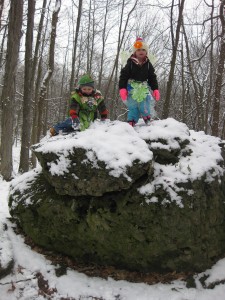
Architect’s Rendering of Musuem’s New Theater. Renderings by Caroline O’Donnell Architecture, provided by It’s a Wonderful Life Museum
BY DEB AND TIM SMITH
We first connected with the It’s a Wonderful Life Museum in 2017 when we spent a day in Seneca Falls doing research and conducting interviews for articles we were working on about that particular museum, which commemorates the classic 1946 film, and also a second article about the National Women’s Hall of Fame. The fact that you can find both of these venerable institutions, as well as Women’s Rights National Historical Park, in a beautiful small town less than 45 minutes away is certainly a fact that warrants consideration for Seneca Falls as a target destination for a day-trip vacation.
That being said, there is actually some significant news to be shared regarding the It’s a Wonderful Life Museum. They recently contacted us with the details which we’ll share with you after providing a nutshell summary of the facility. Its home base is in a 111-year-old movie theatre located at 32 Fall Street, which is the main drag in the heart of beautiful downtown Seneca Falls.
For a two-year period, however, the museum had moved to temporary housing at 76 Fall Street while the original building is undergoing a very exciting renovation project. One irony of this scenario is that the temporary home of the museum is in the old home of the National Women’s Hall of Fame before it moved across the bridge to its current location.
To outline our approach to this article, we are going to…
* Detail the renovations.
* Explain the Seneca Falls connection to the movie.
* Share the donation options which would enable you to personally become a permanent part of the museum.
The renovations to the current museum would include:
• Renovation of the historic building to regain the look of the original movie theater that it housed from 1913-1939. Immigrant Charles Fornesi built the community’s first movie theater in that building in 1913.
• The addition of a 47-seat theater.
• Re-creating selected sets from the film, such as Gower’s Drug Store, Mr. Potter’s office, the Bailey living room, and the staircase with the knob that was lifted off the post in either despair or exhilaration.
• Creating innovative, interactive exhibits that provide the opportunity to reflect on the message of “It’s a Wonderful Life.” These would include an anti-bullying exhibit in Mr. Potter’s office and a laundry basket by the bridge where you can take a Zuzu petal with you as a symbol of hope, or make one to leave for someone else.
• Updating the original exhibits with new lighting and technology.
Quick recap of the movie… Jimmy Stewart and Donna Reed star as George and Mary Bailey, George being an everyman whose financial woes drive him to become suicidal on Christmas Eve. While contemplating his own demise as he’s poised on the bridge in the center of town (think the Bridge Street Bridge in Seneca Falls), George finds himself the benefactor of an intervention by his guardian angel who reveals to George all the lives he has touched and what the world would be like without him.
Accolades from the American Film Institute include…
# 20 greatest movie of all time.
# 8 greatest love story
# 1 most inspirational movie
So how about that Seneca Falls connection? We have the full story for you right here, which is reprised from our 2017 interview with museum trustee Fran Caraccilo. Here’s the story…
In 1945, movie producer Frank Capra leaves his home in Los Angeles to visit actress Jean Arthur in New York City. It is documented that Capra arrives in New York on November 12th. Following a few days of promotional activities, we know he meets with Arthur on November 16th.
After this meeting Capra decides to drive through the Upstate New York Finger Lakes region to visit an aunt he seldom saw. Capra is traveling alone and he stops in Seneca Falls, ostensibly for the purpose of getting a haircut. But he apparently becomes captivated by the small town and spends a good period of time walking the streets and taking note of the village’s quaint charm and unique landmarks.
How do we know this, you might ask? It becomes apparent when Capra ultimately stops for that aforementioned haircut. The local barber at that time is Tom Bellissima, and in an example of Italian immigrant irony, not only are both men immigrants, they both had been born on the island of Sicily, and share the same Sicilian accent. An immediate bond is formed and Capra proceeds to query Bellissima about several of the things he’d seen in town.
The barber Bellissima subsequently shares with museum founder Fran Caraccilo the contents of his in-depth conversation with Capra. At this point, with Fran sharing his story with us, we get kind of an eerie historical feeling passing through us as we realize that we are only one person away from the meeting where Frank Capra was inspired to make Seneca Falls the setting for one of the most revered films of all time.
The range of Capra’s questions make it evident that he has done a thorough evaluation of the village because his queries cover landmarks from one end of the town to the other. But one thing seems to stand out in Capra’s mind.
He is particularly intrigued by the bronze memorial plaque that adorns the bridge over the Erie Canal, which is the centerpiece of the village.
To understand the significance of the plaque we’re going to have to take you back even further in time because the plaque commemorates an event that occurred in 1917, a little over 100 years ago. Cue up the Twilight Zone music.
If you can conjure up the plot of the movie in your head you’ll start to see some significant connections here. In April of 1917 a young woman named Ruth Dunham, despondent over a failed romantic relationship, attempted suicide by jumping off the bridge. A man named Antonio Varacalli witnessed the jump, and along with two friends initiated a rescue. Varacalli dove into the water, swam to midstream, and was able to grab hold of the girl.
Fighting the current and the freezing water, Varacalli was able to drag her toward the shoreline where he succeeded in handing her off to his friend who had waded into the water with a rope tied around his waist, the other end of the rope being secured by the third man on the rescue team.
After delivering the girl to the shoreline, the friend returned to grab Varacalli, but he was gone. Overcome by hypothermia, or exhaustion, or both, he was swept away by the current and his body was found downstream two hours later.
After giving up his own life to save another, Varacalli was subsequently bestowed hero status and the bronze plaque which Capra had seen, was mounted on the bridge at the site from where the girl had jumped. Of the many Seneca Falls nuances Capra experienced that day, none seemed more impactful than the bronze plaque which can still be seen at the same spot it was first displayed 100 years ago.
At the early stages of development, Capra was basing the movie on a short story he had bought the rights to which was named “The Greatest Gift”. In this original story there are no thoughts of suicide and no bridge.
Furthermore, the bridge that eventually appears in the movie is nearly identical to the steel bridge with large metal girders that stretches across the canal in downtown Seneca Falls. At this point the impact that Seneca Falls had on the movie seems to become obvious but there’s more.
Before we share with you the rest of the evidence, for the record, Capra never specifically disclosed a real-life setting for the fictional town of Bedford Falls, the setting in the movie. But he did at one point confide to a friend the fact that his fictional town was indeed based on a real-life place. Capra went on to say that he would never actually specify what that place was because he wanted people in every small town in America to be able to think that it could be their town.
But in our minds there are a few more components of the movie which seem to validate the Bedford Falls = Seneca Falls theory. In the movie there are references to cities that seem to be fairly close to Bedford Falls which include Rochester, Buffalo, and Elmira. Original scripts also show that the college referred to throughout the film is Cornell. Afraid that Cornell might want some type of compensation for the use of their name, the RKO movie company had Capra delete “Cornell” from the script. In the movie all references to that institution of higher learning just say “the college”. That being said, if you take out a map of New York State and connect the dots between Buffalo, Rochester, Elmira and Cornell (Ithaca), you’ve just drawn a box around Seneca Falls.
The specifics will always be lost in the sands of time. But there is a vast amount of evidence that Frank Capra apparently had some type of epiphany that afternoon in Seneca Falls. The short story, upon which the movie was based, had no references to Upstate New York, no bridge, no mention of suicide, and no town with the word “Falls” in the title. Those elements were all added after Capra’s visit to Seneca Falls.
For some reason he was drawn to this village as he clearly spent hours exploring that day. The fact that his experience was coincidentally concluded with a bonding session with a fellow Sicilian apparently confirmed his feelings that when he stumbled upon Seneca Falls that afternoon, he had also stumbled upon the village which would become the setting of the greatest movie he would ever produce and the greatest Christmas film of all time. Capra also identified the film as his personal favorite. It is, indeed, a wonderful life!
So next, what about the fund-raising drive in place to support the renovation project we described earlier? The museum’s president Anwei Law asks you to “Join us to create an innovative, interactive museum that will preserve the history and timeless message of It’s a Wonderful Life for generations to come. Every donation brings us closer to our goal of having the museum completed by December 2026 so that together we can all celebrate the 80th anniversary of It’s a Wonderful Life, the most inspiring film of all time.” The donation options, which can be accessed through the www.wonderfullifemuseum.com website, are delineated below. As you’ll note, there is an extremely wide array of options ranging from buying a bell to lassoing the moon!
$50 – Place a Bell on the Bridge ~ We will place a bell with your name or the name of someone who has impacted your life on the Bridge in Seneca Falls and text a photo to you.
$100 – Place a Star ~ In recognition of Frank Capra’s great interest in astronomy and in remembrance of his “old friend” Edwin P. Hubble, the theater in Seneca Falls’ It’s a Wonderful Life Museum will be filled with stars and planets placed there in memory of people who have made a difference in our lives. Donate to honor a person or persons who have impacted your life.
$250 – Place 3 Stars
$500 – Place 6 Stars
$1,000 – Place a Bell in the Museum ~ A “speaker’s bell” (6” in diameter) will be engraved with the name of the person who has impacted your life and placed in the It’s a Wonderful Life Museum. These are made by the same company that made the bell on the Christmas tree that Zuzu points to at the end of the movie.
$2,000 – Theater Seat Plaque ~ A seat in our new theater will have a plaque engraved with the name of the person who has impacted your life. They will be a permanent part of the museum.
$3,000 – Place a Constellation ~ In recognition of Frank Capra’s great interest in astronomy and in remembrance of his “old friend” Edwin P. Hubble, the theater in Seneca Falls’ It’s a Wonderful Life Museum will be filled with stars and planets, placed there in memory of people who have made a difference in our lives.
$5,000 – Place a Zodiac Constellation ~ A zodiac constellation will honor someone who has impacted your life.
$25,000 – Place a Planet ~ In recognition of Frank Capra’s great interest in astronomy and in remembrance of his “old friend” Edwin P. Hubble, the theater in Seneca Falls’ It’s a Wonderful Life Museum will be filled with stars and planets, placed there in memory of people who have impacted our lives.
$50,000 – Place the Milky Way ~ In recognition of Frank Capra’s great interest in astronomy and in remembrance of his “old friend” Edwin P. Hubble, the theater in Seneca Falls’ It’s a Wonderful Life Museum will be filled with stars and planets, placed there in memory of people who have made a difference in our lives. Donate to place the Milky Way in memory of someone who has impacted your life.
$100,000 – Lasso the Moon ~ In memory of the iconic image of George lassoing the moon, the moon will be placed in honor of a person who has impacted your life.
Editor’s Note: The 78th Anniversary Celebration of “It’s a Wonderful Life” will take place in Seneca Falls, NY on December 13-15, 2024. For details, visit wonderfullifemuseum.com




